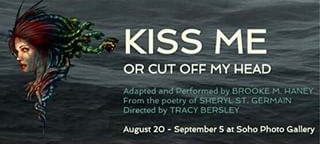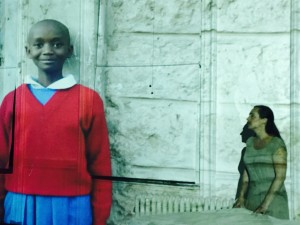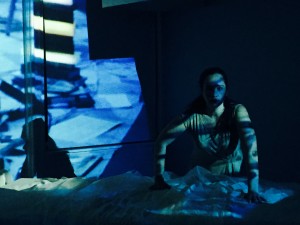ALTRUISM OR ARTISTRY?
Margaret’s Safe Place, “a boarding facility that houses the most vulnerable students of The Kibera School for Girls” in Kenya, sheltering girls from domestic sexual violence, will receive 35% of all proceeds’”ticket and beverage sales’”generated by Brooke M. Haney’s Kiss Me or Cut Off My Head. This isn’t a drop in the bucket. Incredibly, according to Ms. Haney, $100 pays for dinner for one girl for two years. As for the show itself, centered around a modern interpretation of the Medusa myth as an allegory of sexual violence, it is as artistically problematic as it is well-intentioned.
Staged in a rectangular white room (a photo gallery) littered with white sheets of paper, with Kate Goltseva’s B&W photos of contorted female nudes on the walls, and Mary Ellen Stebbins’ flat lighting creating no barrier between performer and the two dozen audience members sitting around on benches, director Tracy Bersley seems to intend Kiss Me Or Cut Off My Head to be an immediate, personal, gut-wrenching experience. But with no characters to empathize with and no discernible dramatic arc the show amounts to sixty minutes of tedium.
Playing Medusa in a less-than compelling, one-note performance charged with anxiety and desperation, Ms. Haney moves through the space, occasionally dropping to the floor to write on sheets of paper, as she recites her adaptation of Sheryl St. Germain’s poetry. But while boasting some beautiful images, Medusa’s poetic monologue is emotionally dull, full of exposition, and as a whole feels disjointed and schizophrenic; nothing builds, nothing sticks. It’s like someone put pieces from many different puzzles into a bucket, swooshed them around, dumped them out on the floor, and left the audience with the impossible task of figuring out how they all fit together. To be fair, poor acoustics and a loud fan whirling in the corner drowned out about a quarter of what she was saying.
The monologue is broken up by projected videos of actors (Amy Barrick, Chengusoyane Kargbo, Ellie Lee, Michael Tyler, and Mia Guzman) portraying victims of sexual violence briefly describing their assaults. The stories are “Based on true accounts of survivors of sexual assault’¦” And while the performers’ deliveries are naturalistic enough to convince the uninformed spectator that they are real people telling real stories, the fact that they’re not begs the question: What is the purpose of these segments? Is it to make us aware of the fact that sexual assault happens in the world? Or that it can take different forms? Or that its victims suffer? If so, these are not sufficient reasons for including them. This is a show after all, and the presence of an element in a show must be justified artistically. These segments are not. (Had the videos contained real people telling real stories they would have been problematic for a series of different reasons.)
Art doesn’t care about humanitarian causes, it doesn’t care about politics or good intentions or what you had for breakfast. Art cares about art: artistry, elegance, economy, beauty. And it will punish an artist who places her loyalties above it; whether vanity or charity’”to Art it makes no difference. Watching Ms. Haney perform one gets the sense that she desperately wants to say something, something vital, to shout it so loud that the whole building trembles’¦except that she’s not sure exactly what she wants to say or how to say it. Unfocussed, her energy dissipates, frantically leaping in every direction at once. The same can be said of her show.
photos by Maren Lavelle
Kiss Me Or Cut Off My Head
Primrose Productions
Soho Photo Gallery, 15 White St
ends on September 5, 2015
for tickets, call (212) 226-8571 or visit KissMeThePlay






{ 2 comments… read them below or add one }
I beg to disagree with this review. I attended on Friday evening 8/22. The set was amazing. I was amazed that the art in the gallery had not been created just for this show. I found out at the talkback after the play that the artist had been chosen to enhance the topic. Brooke Haney did an incredible job of communicating the frustration victims of rape must feel when faced with societies view of victims. Perhaps the above reviewer did not know the story of Medusa when he attended. I had not known it either, but looked it up before I attended to help understand the context.
As to art not caring about humanitarian causes, shame to the reviewer! Art has the ability (and responsibility) to communicate the emotion needed to help others understand to some degree, what they may not themselves have experienced. That would be like saying “Schindler’s List” had no validity.
Yes, the show communicated anxiety and desperation, an emotion surely felt by all victims of rape. I returned Saturday evening to see the play again as it was difficult to process in just one viewing. I would highly recommend this play to anyone.
Dear T Reeder,
Exactly! Schindler’s List, to use your words, has “no validity.” While technically excellent, it’s in terrible taste. Spielberg explores the subject of the Holocaust with the same sensibilities and using the same cinematic language as he does with his action/adventure films. I suspect his artistic world is too limited for profound subject matter (The Color Purple might be an exception). Schindler’s List, at any rate, is a silly film steeped in sentimentality–which tends to fool dilettantes. But its existence, ultimately, is a negative thing.
Art does have the ability, perhaps even the responsibility, “to communicate the emotion needed to help others understand to some degree, what they may not themselves have experienced.” But in order to do that a dramatic work must work on a dramatic level. This show does not. There are a great many people out there, T Reeder, who approve of anything attached to a good cause. This may or may not make them good people, but it makes them terrible viewers, and makes whatever they have to say on the subject of art irrelevant.
I am glad that you liked this show and had time enough to sit through it twice. Artistic issues aside, it is for a good cause and a lot of effort went into staging it. So it’s nice that they’re getting support.
Thank you for your comment.